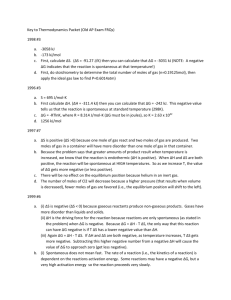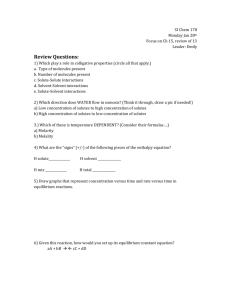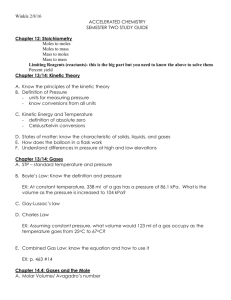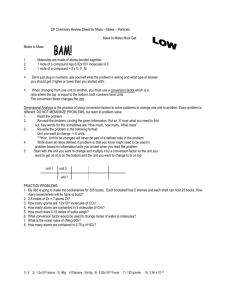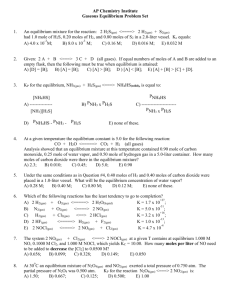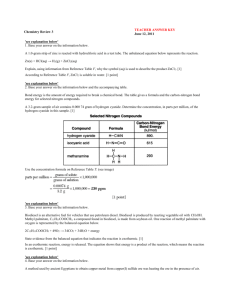Review Sheet for Chemistry 101 exam 3 (by Ethan) Spontaneity
advertisement
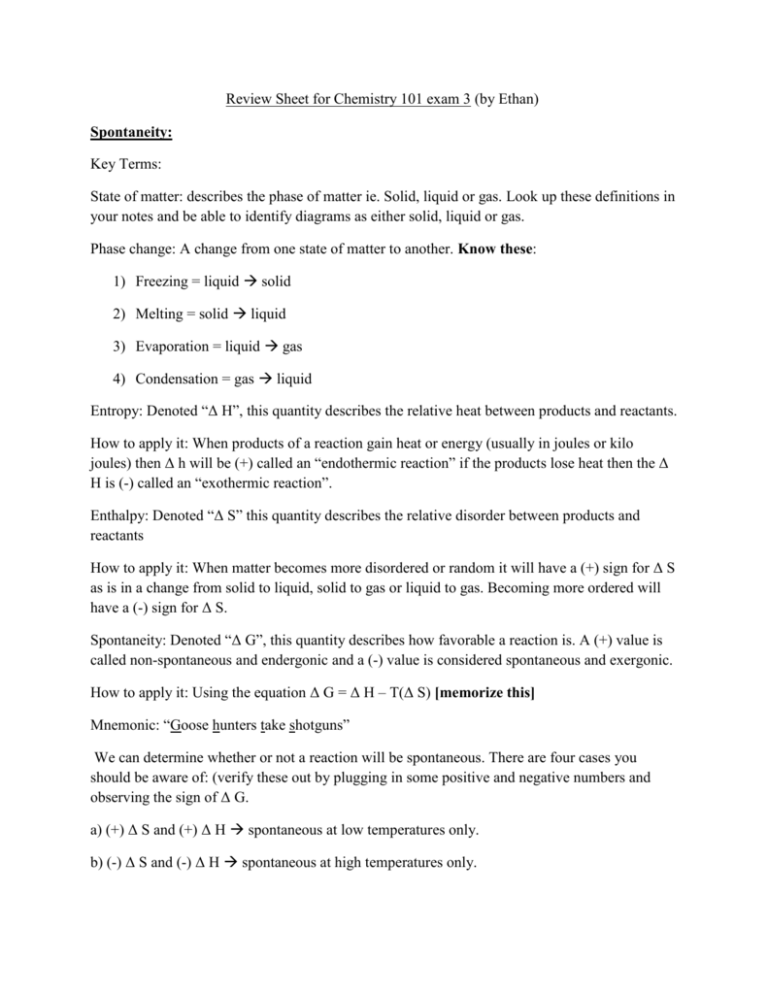
Review Sheet for Chemistry 101 exam 3 (by Ethan) Spontaneity: Key Terms: State of matter: describes the phase of matter ie. Solid, liquid or gas. Look up these definitions in your notes and be able to identify diagrams as either solid, liquid or gas. Phase change: A change from one state of matter to another. Know these: 1) Freezing = liquid solid 2) Melting = solid liquid 3) Evaporation = liquid gas 4) Condensation = gas liquid Entropy: Denoted “Δ H”, this quantity describes the relative heat between products and reactants. How to apply it: When products of a reaction gain heat or energy (usually in joules or kilo joules) then Δ h will be (+) called an “endothermic reaction” if the products lose heat then the Δ H is (-) called an “exothermic reaction”. Enthalpy: Denoted “Δ S” this quantity describes the relative disorder between products and reactants How to apply it: When matter becomes more disordered or random it will have a (+) sign for Δ S as is in a change from solid to liquid, solid to gas or liquid to gas. Becoming more ordered will have a (-) sign for Δ S. Spontaneity: Denoted “Δ G”, this quantity describes how favorable a reaction is. A (+) value is called non-spontaneous and endergonic and a (-) value is considered spontaneous and exergonic. How to apply it: Using the equation Δ G = Δ H – T(Δ S) [memorize this] Mnemonic: “Goose hunters take shotguns” We can determine whether or not a reaction will be spontaneous. There are four cases you should be aware of: (verify these out by plugging in some positive and negative numbers and observing the sign of Δ G. a) (+) Δ S and (+) Δ H spontaneous at low temperatures only. b) (-) Δ S and (-) Δ H spontaneous at high temperatures only. c) (+) Δ S and (-) Δ H spontaneous at all temperatures. d) (-) Δ S and (+) Δ H non-spontaneous at all temperatures. determined by the activation energy (top of hill). Lower activation energy means high reaction rate. Equilibrium / Le Chatlier’s Principle: Equilibrium describes a system that has a constant rate of formation of products and reactants, it does not mean that the system is not changing. We use the letter “k” or “K eq” to put the equilibrium into numerical terms. How to apply it: A large number like 3x10^18 means that the products are favored and a small number like 2x10^-20 means that the reactants are favored. If “K eq” is close to 1 then the products and reactants are nearly equal at equilibrium. [review exponents] Le Chatlier’s Priciple explains how a system will stabilize itself due to a given stress. Rule of thumb: A reaction will compensate for a decrease in concentration of one species by shifting a reaction towards the side of that species in order to maintain equilibrium. The opposite is true if we increase the concentration of a species. [understand this well] How to apply it: Let’s say we have the reaction: A(aq) + B(aq) C(aq) + heat Decreasing the concentration of A will shift the reaction equilibrium to the left while increasing the concentration of A will shift the reaction equilibrium to the right. Note: heat can thought of as a product or reactant. In the above case it is a product (exothermic reaction). Gas Laws (as with spontaneity, try plugging number in and seeing what happens with all of these) Boyles Law: P1V1 = P2V2 (this law says that pressure and volume are inversely related (ie one goes up the other goes down) Charles Law also called Gay-Lussac’s Law: V1/T1 = V2/T2 (this law says that pressure and volume are directly related ie when one goes up the other goes up also) Combined Gas Law: (P1V1)/T1 = (P2V2)/T2 (I recommend just memorizing this last one and deriving the other two if needed) Units that you should be aware of: P= pressure. You may run into atmospheres (denoted “atm”), millimeters Mercury (“mm Hg”) or torr (denoted “t” or simply “torr”) To convert from one to the other: 1 atm = 760 torr = 760 mm Hg [review unit conversions if you didn’t understand this part] V = volume. You will usually use liters “denoted L” but you may run into milliliters also. Remember that 1000mL = 1L. T = temperature. Will usually be in K or degrees Celsius, either one is fine to use but be consistent – if T1 is in Kelvin then T2 must also be in Kelvin. Ideal Gas Law PV = nRT [memorize this] Where n = moles and R = ideal gas constant (NOT RATE!) .08206 (L atm)/(mol K) or .0821 (L atm)/(mol K). This law applies to ideals gases which will be any gas you study in Chem 101, it allows us to make assumptions to make life easier for Chemists. It applies in these conditions: High temperature and low pressure and will deviate (ie not behave ideally) under low temperature and high pressure. Avogradro’s Law: The volume of a gas is directly proportional to the number of moles present (ie. More moles of gas more volume of gas) while temperature and pressure are held constant. Important fact: 1 mole of an ideal gas takes up 22.4L (volume) at STP [memorize this] How to apply: Now we know the volume of ANY ideal gas as long as we know the number of moles – no matter which gas it is! So 1 mole of Hydrogen gas has half the volume compared to 2 moles of Helium. Dalton’s Law of partial pressure: partial pressure of a gas = (mole fraction of gas)(partial pressure of the gas) Mole fraction = mol part/mol whole How to apply it: given a mixture of gases you are able to determine either the partial pressure or amount of moles/mole fraction of a given gas. Intramolecular Forces: describes the types of forces present within a molecule. Use the following procedure: Step 1: Determine the central atom (always the first atom in the compound unless it’s a Hydrogen) Step 2: determine total number of valence electrons (using periodic table) Step 3: draw Lewis Dot Structure following octet rule where it applies. Molecular Geometry: (either be able to visualize these or simply memorize them) I find the AXmEn notation useful. “A” is the central atom, “X” is the number of atoms connected to the central atom and “E” represents the number of lone pairs. Shapes: 1) Linear – AX2 has a 180 degree angle between electron pairs. 2) Bent – AX2E2 has a 109.5 degree angle between electron pairs. 3) Trigonal planar (flat)– AX3 has a 120 degree angle between electron pairs. 4) Tetrahedral – AX4 has a 109.5 degree angle between electron pairs. Types of Intramolecular forces: (from strongest to weakest) [you must know all four] 1) Ionic: Formed between a metal and non-metal. (strongest) 2) Hydrogen bonding: Hydrogen bonded to either F, O or N. 3) Polar Covalent: formed between elements with an electro-negativity difference of at least 1.0 (use values in text). Some compounds may contain polar bonds but be non-polar overall due to their geometry. 4) Non-polar covalent or just non-polar: formed between elements with an electro-negativity or less than one. (weakest) Solutions : a uniformly distributed liquid, combines two or more substances irreversibly. Concentration = molarity = moles/liter (denoted “M” a solution of 5mol/liter is called “5 molar”) How to apply it: You can determine the concentration of a solution given the number of moles of a substance and given its volume (in liters) or if you know the molarity you can solve for moles or volume. Dilution Equation: M1V1 = M2V2 How to apply it: use the above equation to figure out new concentration or a diluted or concentrated solution. Solubility: One substance is said to be soluble in another if the two have similar types of intermolecular forces. Rule of thumb: “like dissolves like” so two polar substances will be soluble like salt and water but one carbon dioxide (non-polar) is not soluble in water (polar).
